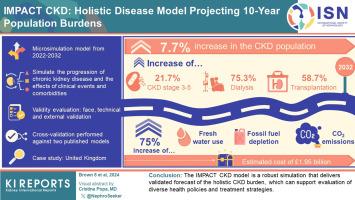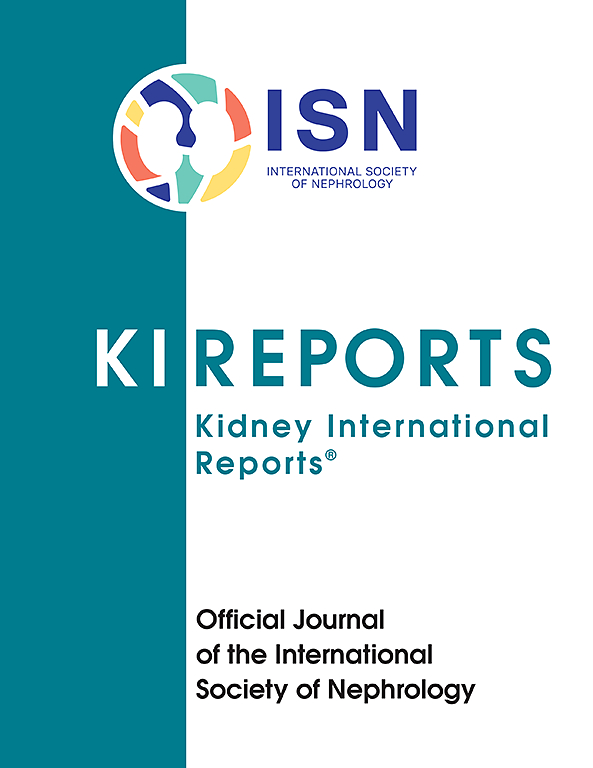IMPACT CKD: Holistic Disease Model Projecting 10-Year Population Burdens
IF 5.7
2区 医学
Q1 UROLOGY & NEPHROLOGY
引用次数: 0
Abstract
Introduction
The significant burden of chronic kidney disease (CKD) is not recognized as a global public health priority, although policies aimed at delaying progression to later stages are required. Therefore, there is need for a holistic disease model to inform decision making that accounts for the multidimensional impact of CKD, and the interrelated factors that modulate progression.
Methods
IMPACT CKD is a microsimulation model that simulates CKD progression and incorporates the effect of clinical events and comorbidities. CKD status is assigned using estimated glomerular filtration rate (eGFR) and albuminuria levels, and CKD progression is predicted by an annual eGFR decline rate. The model projects clinical, health care resource use, economic, patient, societal, and environmental burdens from 2022 to 2032. During development, face, technical, and external validity were evaluated, with calibration conducted to population data. Further, cross-validation was conducted against 2 published models. The United Kingdom (UK) was selected as the case study for validation.
Results
A 7.7% increase in the CKD population by 2032 was predicted, with increasing numbers of patients with CKD stage 3 to 5 (21.7%), dialysis (75.3%), and transplantation (58.7%). The increase of patients on renal replacement therapy (RRT) results in an increase of 75% across freshwater use, fossil fuel depletion, and CO2 emissions over the next decade, and an estimated cost of £1.95 billion in 2032. Projections reflect validated findings from other models.
Conclusion
The IMPACT CKD model is a robust simulation that delivers validated forecasts of the holistic CKD burden, which can support evaluation of diverse health policies and treatment strategies.

IMPACT CKD:预测 10 年人口负担的整体疾病模型
慢性肾脏病(CKD)造成的巨大负担并未被视为全球公共卫生的优先事项,尽管需要制定旨在延缓病情恶化至晚期的政策。因此,我们需要一个全面的疾病模型来为决策提供信息,该模型应考虑到慢性肾脏病的多方面影响,以及影响病情发展的相互关联的因素。IMPACT CKD 是一个微观模拟模型,可模拟慢性肾功能衰竭的进展,并将临床事件和合并症的影响纳入其中。通过估算肾小球滤过率(eGFR)和白蛋白尿水平来确定 CKD 状态,并通过每年的 eGFR 下降率来预测 CKD 进展。该模型预测了 2022 年至 2032 年的临床、医疗资源使用、经济、患者、社会和环境负担。在开发过程中,对表面、技术和外部有效性进行了评估,并根据人口数据进行了校准。此外,还与两个已发布的模型进行了交叉验证。英国(UK)被选为验证案例。据预测,到 2032 年,CKD 人口将增加 7.7%,CKD 3 至 5 期患者(21.7%)、透析患者(75.3%)和移植患者(58.7%)的人数都将增加。接受肾脏替代疗法 (RRT) 的患者人数增加导致未来十年淡水使用量、化石燃料消耗量和二氧化碳排放量增加 75%,2032 年的估计成本为 19.5 亿英镑。预测结果反映了其他模型的验证结果。IMPACT CKD 模型是一种稳健的模拟,可对整体 CKD 负担进行有效预测,从而为评估各种健康政策和治疗策略提供支持。
本文章由计算机程序翻译,如有差异,请以英文原文为准。
求助全文
约1分钟内获得全文
求助全文
来源期刊

Kidney International Reports
Medicine-Nephrology
CiteScore
7.70
自引率
3.30%
发文量
1578
审稿时长
8 weeks
期刊介绍:
Kidney International Reports, an official journal of the International Society of Nephrology, is a peer-reviewed, open access journal devoted to the publication of leading research and developments related to kidney disease. With the primary aim of contributing to improved care of patients with kidney disease, the journal will publish original clinical and select translational articles and educational content related to the pathogenesis, evaluation and management of acute and chronic kidney disease, end stage renal disease (including transplantation), acid-base, fluid and electrolyte disturbances and hypertension. Of particular interest are submissions related to clinical trials, epidemiology, systematic reviews (including meta-analyses) and outcomes research. The journal will also provide a platform for wider dissemination of national and regional guidelines as well as consensus meeting reports.
 求助内容:
求助内容: 应助结果提醒方式:
应助结果提醒方式:


